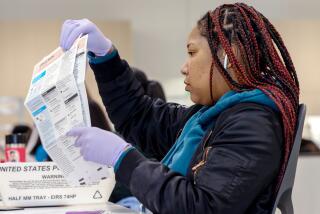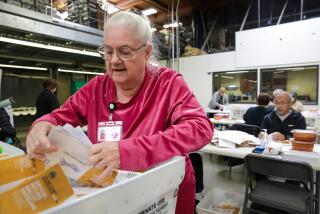Neither rain nor sleet nor those-funny looking codes shall stop the mail
Domenick Rossetti, a 21-year Postal Service veteran from West Covina, was irritated by a glitch in the system at the major mail-processing center for the San Gabriel Valley.
Rossetti, an electrical technician who helps make sure that the equipment runs smoothly at the Alhambra Mail Processing Center, saw letters with computer-coded addresses being handled like regular mail, needlessly clogging the 700,000 letter-a-day mail-processing system.
“I said to myself, ‘I don’t want all this mail in here.’ It really irked me.”
He said he heard that the post office had been working to solve the problem, but that the proposed solution “didn’t make it on the floor. It was nice in theory, but it broke down in the middle of the night.”
Rossetti, who has won five incentive awards and earned at total of $20,000 in bonuses for his suggestions, went at solving yet another problem.
But he needed money and help to test his solution.
With a $1,700 grant from the Postal Service and the assistance of two colleagues, Rossetti found a reliable way to separate pre-coded mail so that it bypasses a complicated processing machine that requires 19 people to operate.
The coded mail, marked with bars similar to those used on grocery items, is diverted to a laser-equipped machine that is much less expensive and requires only two people to operate.
The device has been dubbed the “Alhambra Mod,” for the Alhambra mail center, where Rosetti and his two colleagues work. The center, in the City of Industry, serves a the central processing point for all mail in the San Gabriel and Pomona valleys.
Rossetti said that the Alhambra Mod modifies the Mark II, a $30,000 machine through which all mail is first processed. With the new device, computer-coded letters are picked out from regular mail with 99% reliability.
The Alhambra Mod works so well that it is expected to save the U.S. Postal Service $5.2 million a year in labor and operating expenses after the system goes into effect nationwide next August. It is also expected to extend the life of the 1,000 Mark IIs in operation around the country.
For his efforts, Rossetti received his sixth incentive award and will split $35,000 with co-workers Bill Azelton of West Covina and Kirk Bodily of Glendora, who also received incentive awards.
Only once before has so much money been awarded for a suggestion, said Joseph Breckenridge, a Postal Service spokesman.
Postal officials lauded the the trio’s efforts.
“It takes perseverance and patience to develop an idea and see it through, but it’s worth the effort,” said Hector Godinez, manager of the Santa Ana division of the Postal Service, under whose jurisdiction the center falls.
According to Breckenridge, many businesses now print computer codes on return-mail envelopes so that payments will get to them faster and more reliably. As much as 20% of all U.S. mail is now computer-coded, Breckenridge said.
So far, six machines at the Alhambra center have been modified, at a cost of $25,000. The Alhambra center workers traveled to the Postal Service’s research units in Rockville, Md., and Memphis, Tenn., to demonstrate and perfect the device.
“Kirk and I did the mechanical end,” said Azelton, who has been with the post office for 13 years. He said he and Bodily, who has been with the Postal Service for 12 years, were paid for the time during the weekends they spent working on the device.
“People take mail for granted,” Azelton said. “They get their bills every day, but they don’t realize the effort that goes into” the delivery process.
More to Read
Sign up for Essential California
The most important California stories and recommendations in your inbox every morning.
You may occasionally receive promotional content from the Los Angeles Times.










